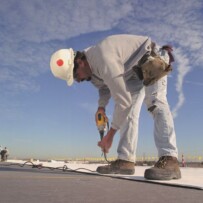
Spring is near, and with the warmer weather also comes higher amounts of rainfalls and storms. Before the rainy season sets in, you will want your roof in top condition and ready for whatever weather you might face.
One of the best times to perform a roofing inspection is after the worst of winter is over. It is a safer time to get out on the roof, without the fear of slipping on ice, and inspect it for any damage brought on by heavy snowfall or high winds. Some areas of the country experienced record snowfalls this winter. These areas should pay extra attention to their spring roof inspection. Generally, a minimum of two roof inspections should be performed every year, one in the spring and one in the fall.
Before you can start a roof inspection, it is imperative to spend time clearing off any debris that is left over from the winter. Keeping your roof clean will help maintain its solar reflectance and energy efficiency, if you have a TPO or other reflective membrane. Clearing your roof will also make it easier to spot tears or punctures in the roofing membrane.
A few key factors to keep in mind when performing a roof inspection include:
• The seams of your roofing membrane are more susceptible to leaks. A thorough inspection from a professional roofer can help prevent these minor repairs from becoming major problems. A professional roofer may be needed to reseal any areas that appear to leak.
• Low-slope roofs are designed to drain within 24 – 72 hours, so if you notice areas of your roof that retain water for longer periods, you should investigate the problem and call a roofing professional for a more in-depth roof inspection.
• Drainage issues should be a top priority to inspect after winter. Any buckling of the roof that creates standing water could indicate a much more serious issue at the roof decking.
To ensure your roof is ready for a rainy spring, be sure to have it inspected.
For more information on GenFlex products and programs, visit www.GenFlex.com – or to request training on product-specific installation and maintenance practices, click here.
